Introduction to Soccer Field
A soccer field is the heart of the game. Every match, from casual backyard play to professional tournaments, happens on this carefully marked surface. Without a proper field, the game lacks structure and fairness. The importance of a soccer field lies in its ability to provide a consistent playing surface that allows for strategy, skill, and teamwork to shine.
The history of soccer field design dates back to the 19th century when England first formalized the rules. Early fields varied greatly in size and markings. Over time, standard dimensions and layouts were established by FIFA and other governing bodies to ensure uniformity worldwide.
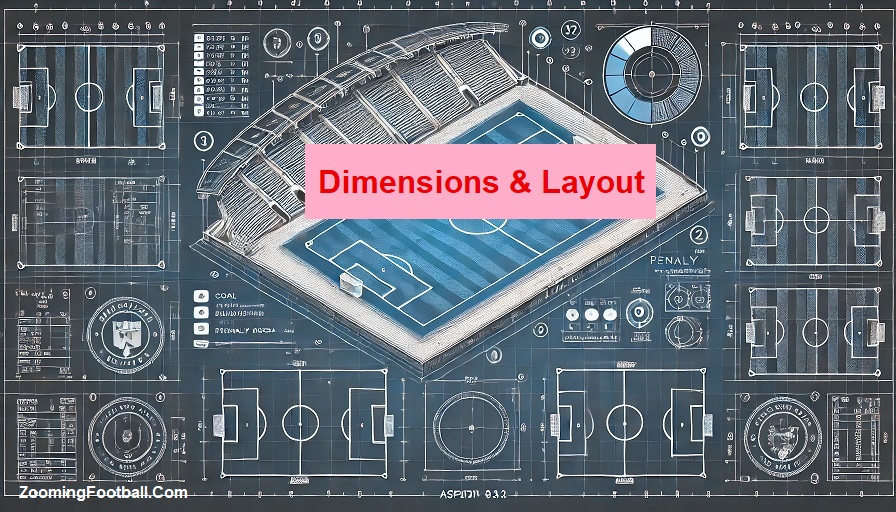
Standard Soccer Field Dimensions and Layout
According to FIFA regulations, a soccer field size must be between 100-110 yards long and 50-100 yards wide for
standard matches. MLS and NCAA fields follow similar guidelines, ensuring fair play.
Table: Soccer Field Dimensions
| Section | Minimum (yards) | Maximum (yards) |
| Length | 100 | 110 |
| Width | 50 | 100 |
| Penalty Area | 18 | 18 |
| Goal Area | 6 | 6 |
| Center Circle | 10 | 10 |
The penalty area, goal area, and center circle are essential parts of the field. They define boundaries for penalties, goalkeeping, and kickoff zones. The goalposts must be 8 feet high and 8 yards wide. Corner arcs, though small, help determine the exact placement of corner kicks, which can impact game strategies significantly.

Components of a Soccer Field
The playing surface varies between natural grass and artificial turf. Grass fields require regular maintenance but offer a natural playing experience. Artificial turf fields, though easier to maintain, can affect ball movement and player comfort.
Field markings, such as boundary lines, penalty boxes, and centerlines, ensure fairness. Goalposts and nets must be sturdy to withstand powerful shots. Corner flags help referees judge offside positions, while technical areas and substitution zones keep coaching staff organized during matches.

Types of Soccer Fields
There are different types of soccer fields, each catering to various playing needs. Natural grass fields are common in professional leagues but need careful upkeep. Artificial turf fields are durable and popular in regions with extreme weather. Hybrid fields combine both for optimal playability. Indoor soccer fields allow games in controlled environments, while futsal courts offer a smaller, faster-paced version of the game.
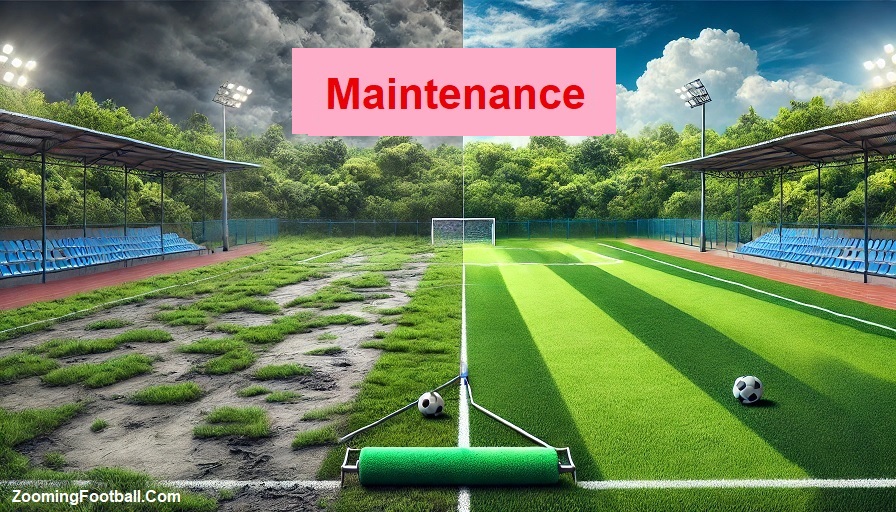
Soccer Field Maintenance
Proper field maintenance ensures safety and playability. Grass fields need mowing, watering, and fertilizing to stay in top condition. Artificial turf maintenance includes brushing and disinfecting to prevent wear. Weather conditions like rain and snow can damage fields, requiring special care. Common challenges, such as field erosion and uneven surfaces, demand ongoing maintenance.
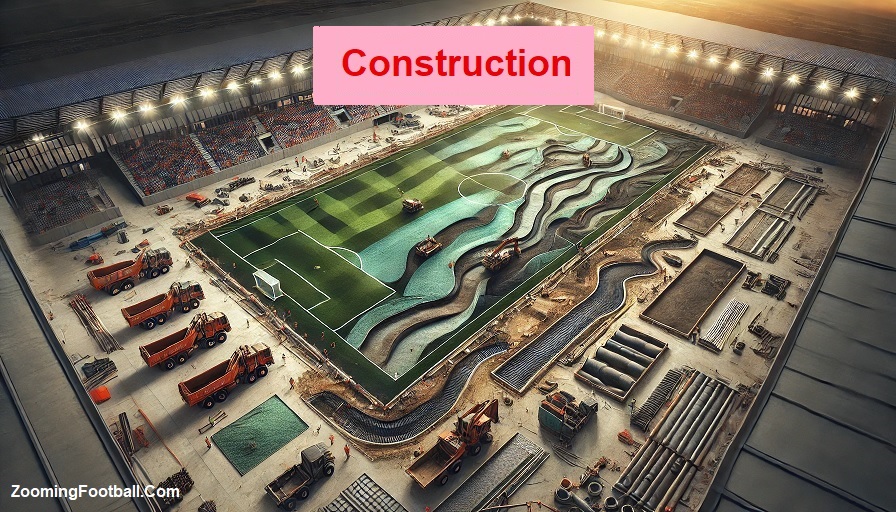
Soccer Field Construction
Building a soccer field requires careful planning and design. Choosing the right location affects drainage and accessibility. Materials like high-quality grass, synthetic turf, and proper goalposts influence durability. Drainage systems prevent flooding, making the field usable year-round. The cost of building a soccer field can range from $100,000 to over $1 million, depending on materials and location.
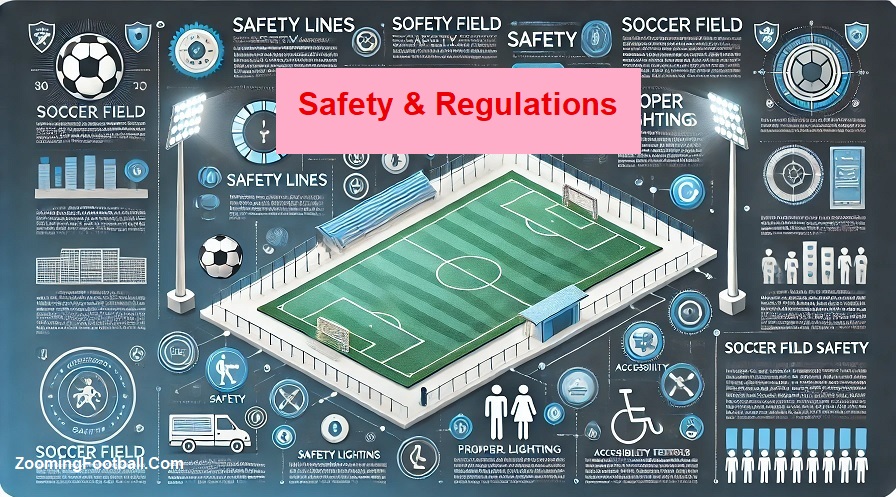
Soccer Fields Safety and Regulations
Safety on a soccer field is crucial. Proper field markings prevent confusion and disputes. Lighting systems ensure night games meet visibility standards. Fields must also be accessible for all players and spectators. Compliance with local and international regulations ensures player safety and match integrity.

Famous Soccer Fields Around the World
Some soccer fields are legendary. Wembley Stadium in England is known as the “Home of Soccer.” Maracanã Stadium in Brazil has hosted historic matches. Camp Nou, home to FC Barcelona, is the largest stadium in Europe. Each of these fields has unique features that make them iconic.
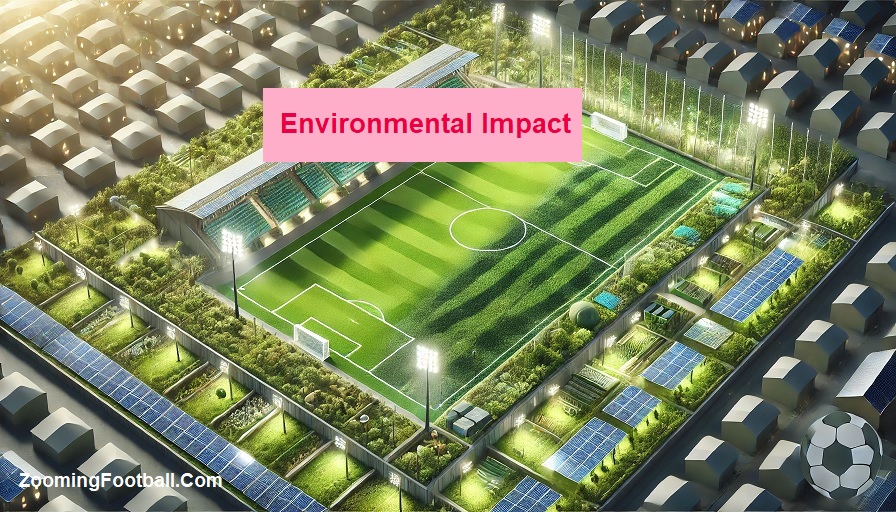
Environmental Impact of Soccer Fields
Soccer fields affect the environment. Water usage for grass fields is high, while artificial turf has a large carbon footprint. However, sustainable practices like rainwater harvesting and eco-friendly innovations like organic infill materials are reducing environmental damage.
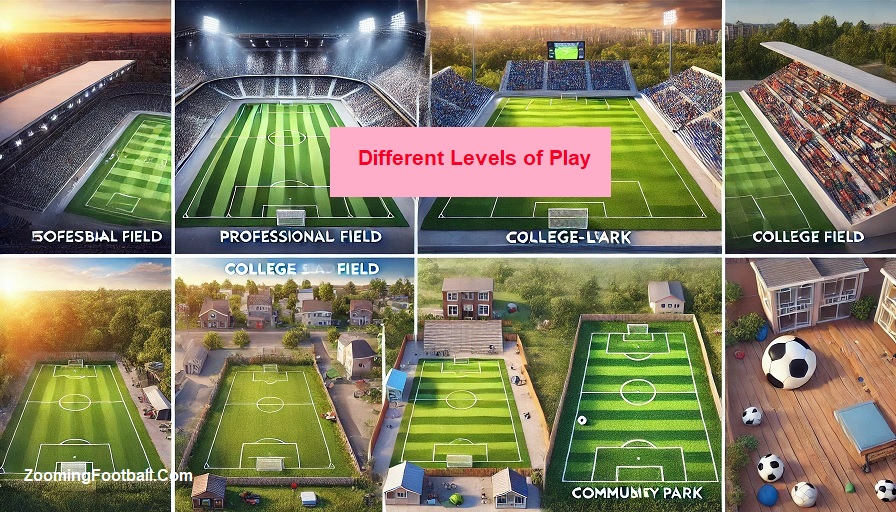
Soccer Fields for Different Levels of Play
Different leagues use different soccer fields. Professional fields follow strict regulations. College and high school soccer fields vary in size but still require maintenance. Community fields are used for recreational play, while backyard soccer fields let enthusiasts enjoy the game at home.

Technology and Innovation in Soccer Fields
Modern soccer fields are integrating technology. Smart fields monitor field conditions in real-time. LED lighting systems improve energy efficiency. Advanced turf technologies make artificial fields more natural. VAR (Video Assistant Referee) enhances decision-making. The future of soccer field design includes AI-driven field management.
Soccer Field Etiquette and Rules
Players and fans must respect the field. Proper use of the field during matches and training is essential. Spectators must follow stadium rules to ensure safety. Handling emergencies, such as injuries, is also critical for maintaining a safe playing environment.
Interesting Fun Facts
The Most Extreme Soccer Fields on Earth
- The world’s steepest soccer field is in La Paz, Bolivia, where the stadium sits at 3,600 meters (11,800 feet) above sea level. Visiting teams often struggle with breathing due to the thin air!
- In Greenland, soccer is played on fields made of gravel and ice because grass can’t grow in the extreme cold.
- The World’s Coldest Soccer Field? A match was once played in Yakutsk, Russia, where temperatures reached -49°F (-45°C)!
The Weirdest Places You Can Play Soccer
- There’s a soccer field inside a prison! Inmates at San Pedro Prison in Bolivia have their own league.
- In Norway, there’s an official FIFA-sized soccer field inside a cave, known as the Grotto Hall.
- A village in England has a field on a hill, where one half of the pitch is 10 feet higher than the other! Imagine running uphill to score a goal.
Bizarre and Illegal Soccer Fields
- A stadium in Mexico was once built partially underground to avoid paying property taxes!
- Some secret underground soccer fields exist in bunkers in Switzerland and Russia, originally designed for military training.
- North Korea has a hidden soccer stadium where only government-approved games can be played!
The Most Dangerous Soccer Fields
- The Azteca Stadium in Mexico is believed to be haunted after multiple players reported seeing ghosts in the locker rooms.
- Some soccer fields in Brazil are built in areas with high crime rates, where players have been robbed during games!
- A match in Congo had to stop after a lightning strike hit the field, instantly killing an entire team of 11 players while the opponents were left unharmed!
Unbelievable Weather and Natural Disasters on Soccer Fields
- A stadium in Turkey was struck by a tornado in the middle of a match, but the game continued after it passed!
- In Japan, an earthquake once created a massive crack in a soccer field, splitting it in two right before a game.
- The Most Flooded Soccer Field? In Indonesia, a stadium gets so much rain that players must swim to get the ball!
Soccer Fields That Shouldn’t Exist
- There’s a soccer field in the middle of the Amazon rainforest, where players are surrounded by wild animals!
- A stadium in China was built inside an abandoned airport, and players can still see parts of the old runway.
- In Thailand, there’s a floating soccer field that moves with the tide, making it nearly impossible to play normally.
Animals That Invaded Soccer Fields
- A match in South Africa was delayed after a lion walked onto the field and refused to leave!
- In Australia, a kangaroo hopped onto a soccer field during a professional match, stopping the game for several minutes.
- A game in Argentina had to be paused when hundreds of bees swarmed the goalposts, forcing players to run for cover!
The Most Expensive and Valuable Soccer Fields
- Officials insured the grass at Wembley Stadium for $38 million because they consider it the perfect soccer field! 💰⚽🏟️
- The Most Expensive Soccer Field Ever Built? The stadium in Qatar for the 2022 World Cup cost $220 billion to build!
- Some soccer fields have gold-plated goalposts, including a private stadium owned by a billionaire in Dubai.
Most Haunted Soccer Fields 👻
- Maracanã Stadium in Brazil is rumored to be haunted by the ghosts of fans who never left after passing away in their seats. Security guards have reported hearing phantom cheers and footsteps at night!
- In Scotland, builders constructed an old soccer field on top of a graveyard! ⚽🪦 Players often claim they hear whispers under the field during matches.
- A witch allegedly cursed a stadium in Italy, causing the home team to lose almost every game for a decade—until they finally broke the hex! 🏟️🧙♀️⚽
The Most Illegal and Controversial Soccer Fields 🚫
- In Colombia, drug lord Pablo Escobar built his own private soccer field for himself and his cartel members. Officials forced some of the most famous players of the time to play there! ⚽🏆
- A stadium in North Korea was once the site of a fake World Cup, where government officials staged a tournament that never actually happened.
- The smallest soccer field in the world sits in the middle of a prison in El Salvador, where only the most dangerous criminals get to play! ⚽🚔
Soccer Fields Built in Impossible Places 🏔️🌊
- In the Himalayas, there’s a field at an altitude of 5,000 meters (16,400 feet), making it the highest soccer field in the world. Players have to carry oxygen tanks to avoid altitude sickness!
- The lowest soccer field in the world is in the Dead Sea region, sitting at 423 meters (1,388 feet) below sea level. The air is so heavy that the ball moves slower than normal.
- Scientists working at a research station in Antarctica use a soccer field for games! ❄️⚽. They play on ice and snow, and the game often has to stop when penguins invade the field!
Soccer Fields That Disappear and Move 🏝️
- In Dubai, there’s a floating soccer stadium that moves with the waves. Players have to adjust to the constantly shifting surface! You may also like: Soccer Field vs Football Field
- In Indonesia, high tide completely submerges the stadium, making the field disappear underwater! 🌊🏟️
- In Alaska, shifting permafrost constantly moves the soccer fields, forcing officials to re-measure the lines and goalposts every year! ❄️⚽
The Most Dangerous Soccer Field in the World ⚠️
- Builders constructed a soccer stadium inside an active volcano crater in Mexico. If the volcano erupts, it could wipe out the entire field! 🌋⚽
- A soccer field in Nigeria is located right next to an airport runway. Players have to pause the game every time a plane takes off!
- Builders constructed a stadium over a crocodile-infested swamp in Thailand! 🏟️🐊 . Officials placed special barriers onto the field, but crocodiles still sneak around! 🐊
The Strangest Soccer Field Rules Ever 🧐
- In Nepal, a stadium enforces a rule where referees count goals only if players score with their left foot! ⚽👟
- A soccer field in Japan has a “no yelling” rule, where players must stay silent to avoid disturbing nearby temples.
- Some soccer fields in Tibet ban goal celebrations because of religious customs. Players have to keep their emotions in check after scoring!
Mind-Blowing Soccer Field Technology of the Future 🤖
- Engineers designed a stadium in Qatar with air-conditioned grass, ensuring the field stays at a perfect temperature even in extreme heat! ❄️🏟️🔥
- Some soccer fields now feature self-healing grass that uses nanotechnology to repair itself after damage! 🌱⚽🔬
- A team in Germany is testing a holographic soccer field, where players wear VR goggles to see a completely customizable pitch!
FAQs About Soccer Field
What is the ideal size of a soccer field?
FIFA recommends a field between 100-110 yards long and 50-100 yards wide.
How often should a soccer field be maintained?
Grass fields need weekly care, while artificial turf should be cleaned and brushed monthly.
Can soccer fields be used for other sports?
Yes, many soccer fields also host lacrosse, rugby, and American football.
What is the cost of building a soccer field?
Costs range from $100,000 to over $1 million, depending on materials and location.
How do weather conditions affect soccer fields?
Heavy rain can cause flooding, while extreme heat makes artificial turf uncomfortable to play on.
Conclusion: Soccer Field
Soccer fields are more than just playing surfaces. They are essential to the sport, providing space for competition, training, and enjoyment. Their design and maintenance influence game quality and player safety. As technology advances, soccer fields will continue to evolve, ensuring the game remains exciting for players and fans alike.

Oliver Brown, a seasoned football blogger with a knack for insightful commentary, brings decades of passion and expertise to Zooming Football. Known for his sharp analysis and engaging storytelling, Oliver delves deep into the game’s nuances, offering readers a unique perspective on football’s most captivating stories and strategies.







